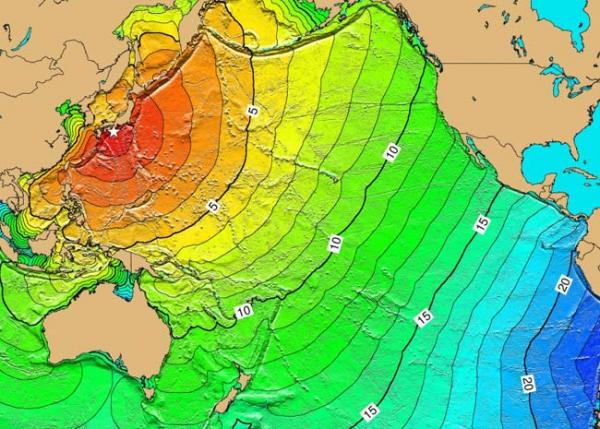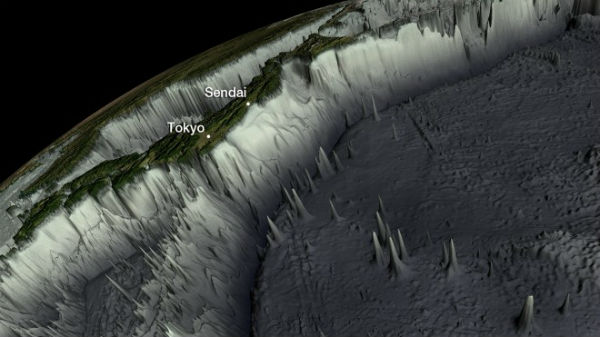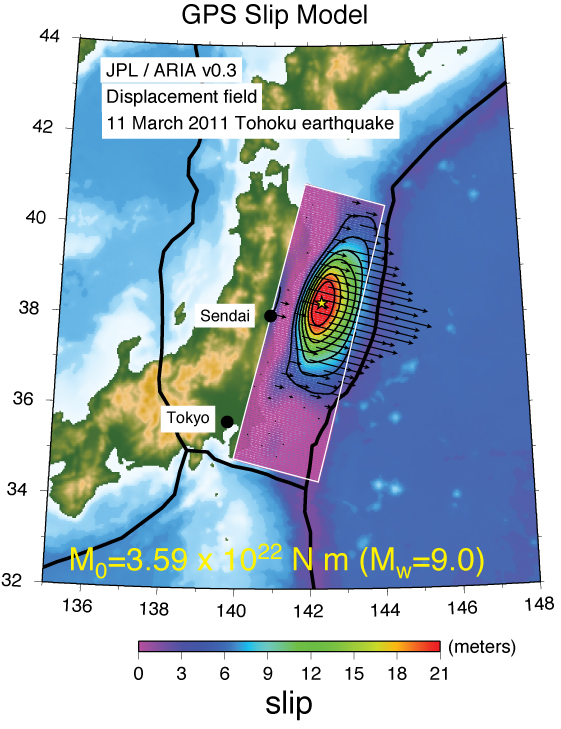WE WATCH: Is Japan going to sink?! pt.3 – Seabed shifted by 50 meters (165 feet) – the largest slip yet recorded

The massive waves were triggered by a devastating 9.0-magnitude earthquake that struck Japan last March and crippled the Fukushima Dai-ichi nuclear power plant, gave the sea floor a huge shove toward Honshu, Japan’s largest island. But until now it has been unclear how much the earth moved due the strong earthquake. A new look at the sea floor reveals massive shift in the ocean crust. Energy from the uplifted sea floor — which was thrust 50 meters (164 feet) horizontally and 10 meters (33 feet) vertically— triggered the immense tsunami waves that struck the coast of Japan. The mega-thrust earthquake originated at a depth of 32 km near the subduction zone plate boundary between Pacific and North American plates (see USGS report).

In the past, scientists have had to deduce seabed shifts via seismic waves emitted by an earthquake. But that requires computer modeling, and the results can be frustratingly uncertain. Toshiya Fujiwara, a geophysicist at the Japan Agency for Marine-Earth Science and Technology (JAMSTEC) said that extraordinarily, abnormally huge earthquake made it possible for scientists to detect the shift with common sea-floor-survey techniques. Fujiwara’s team used multibeam bathymetric surveys — which use echolocation to measure water depth and the shape of the underlying sea floor — to map areas around the Japan Trench after the quake. The team compared it with similar data taken in 1999 and 2004 from the same swath of sea floor. The difference between the data sets revealed large displacements in the ocean crust — more than 100 times greater than shifts measured after other earthquakes. Most quakes give the sea floor a gentle nudge, but the Tohoku quake gave it a huge shove.
“Previously, we thought the displacement stopped somewhere underground, but this earthquake destroyed the entire plate boundary.“Toshiya Fujiwara, JAMSTEC geophysicist
In addition to the 10-meter (33-foot) vertical shift, a large slab of ocean crust between the Japan Trench and the Honshu coast was boosted upward another 4-6 meters (12-18 feet) or more, Fujiwara’s team found. This uplift helped generate the “massive pulsating pattern of tsunami waves” that hit Japan, the team explains in their paper, which appear in the Dec. 2 issue of the journal Science. The fault that shifted the ocean crust so dramatically likely extends all the way to the axis of the Japan Trench further highlighting the magnitude of the Tohoku quake. (OAP)

March 11 Tsunami felt reports
Landslides occurred in Miyagi. Liquefaction observed at Chiba, Odaiba, Tokyo and Urayasu. The tsunami destroyed or severely damaged many coastal towns in the Kuji-Minamisanriku-Nami area. One person killed and several houses destroyed at Jayapura, Indonesia by a tsunami with a wave height of 2 m. One person killed south of Crescent City, California and several boats and docks destroyed or damaged at Crescent City by a tsunami with a recorded wave height of 247 cm. Several houses, boats and docks destroyed or damaged at Santa Cruz, California; Brookings, Oregon; Hale`iwa, Kailua Kona and Kealakekua, Hawaii. Some buildings damaged slightly in the Galapagos Islands, Ecuador by a tsunami with a recorded wave height of 208 cm at Santa Cruz. Several houses destroyed at Pisco, Peru. Several buildings destroyed at Dichato and several boats damaged at Puerto Viejo and on Isla Chiloe, Chile. Felt (VIII) at Fukushima, (VII) at Agui, Hiratsuka, Kiryu, Komae, Oyama, Sendai and Tsukuba and (VI) in much of eastern Honshu, including the Tokyo-Yokohama area, Japan. Felt from Hokkaido to Kyushu. Recorded (7 JMA) in Miyagi. Felt in Northern Mariana Islands, North Korea, South Korea, Taiwan, northeastern China and southeastern Russia as far as Kaohsiung, Beijing and Petropavlovsk-Kamchatskiy. Seiches observed at Leikanger, Norway. Water fluctuations observed in a well in Newfoundland, Canada. The tsunami had maximum runup heights of 29.6 m at Ofunato, 18.4 m at Onagawa and 9.4 m at Iwaki. The tsunami also caused some massive slabs of ice to calve from the Sulzberger Ice Shelf, Antarctica.
The magnitude 9.0 earthquake that struck Japan was powerful enough to shorten Earth’s day by 1.8 microseconds and throw an extra 6.7 inches (17 centimeters) into the planet’s wobble, scientists say. That doesn’t mean shockwaves from the event somehow knocked Earth off its north-south axis, around which the planet revolves. Instead the quake shifted what’s called Earth’s figure axis, an imaginary line around which the world’s mass is balanced, about 33 feet (10 meters) from the north-south axis.
The shifting mass also affected the planet’s spin rate, according to geophysicist Richard Gross, of NASA’s Jet Propulsion Laboratory in Pasadena, California. Researchers are more intrigued by the change in Earth’s wobble, which could inform future space missions, and the data collected on small earthquakes leading up to the main event, which may help with earthquake prediction. Similar changes to Earth’s mass distribution were calculated from GPS data obtained during the 2004 Sumatra earthquake and the 2010 Chile earthquake. In the case of Sumatra, the change in the length of the day was larger: 6.8 microseconds. But for the Japan earthquake, the change in Earth’s wobble was more than twice as large as those calculated for the 2004 and 2010 events.

Tectonic summary
The location, depth, and focal mechanism of the March 11 earthquake are consistent with the event having occurred on the subduction zone plate boundary. Modeling of the rupture of this earthquake indicate that the fault moved upwards of 30-40 m, and slipped over an area approximately 300 km long (along-strike) by 150 km wide (in the down-dip direction). The rupture zone is roughly centered on the earthquake epicenter along-strike, while peak slips were up-dip of the hypocenter, towards the Japan Trench axis. The March 11 earthquake was preceded by a series of large foreshocks over the previous two days, beginning on March 9th with a M 7.2 event approximately 40 km from the epicenter of the March 11 earthquake, and continuing with another three earthquakes greater than M 6 on the same day.

The Japan Trench subduction zone has hosted nine events of magnitude 7 or greater since 1973. The largest of these, a M 7.8 earthquake approximately 260 km to the north of the March 11 epicenter, caused 3 fatalities and almost 700 injuries in December 1994. In June of 1978, a M 7.7 earthquake 35 km to the southwest of the March 11 epicenter caused 22 fatalities and over 400 injuries. Large offshore earthquakes have occurred in the same subduction zone in 1611, 1896 and 1933 that each produced devastating tsunami waves on the Sanriku coast of Pacific NE Japan. That coastline is particularly vulnerable to tsunami waves because it has many deep coastal embayments that amplify tsunami waves and cause great wave inundations. The M 7.6 subduction earthquake of 1896 created tsunami waves as high 38 m and a reported death toll of 22,000. The M 8.6 earthquake of March 2, 1933 produced tsunami waves as high as 29 m on the Sanriku coast and caused more than 3000 fatalities.
Continuing readjustments of stress and associated aftershocks are expected in the region of this earthquake. The exact location and timing of future aftershocks cannot be specified. Numbers of aftershocks will continue to be highest on and near to fault-segments on which rupture occurred at the time of the main-shock. The frequency of aftershocks will tend to decrease with elapsed time from the time of the main shock, but the general decrease of activity may be punctuated by episodes of higher aftershock activity. The risks of great earthquakes at locations far from northern Honshu are neither significantly higher nor significantly lower than before the March 11 main-shock.
Numerous small repeating earthquakes have occurred along the Japan Trench along the entire area between ∼ 35.5°N and 38°N, most intensely south of about 37°N


The reported measurements confirm my measurements based on earthquake data for the vertical shift(16 meters). But ascribing that to plate tectonics is unacceptable deductive logic. The vertical force that plate tectonics can muster is that due to a pressure of 100 Atm or 10 km/square meter. The required force is that due to a water pressure head change. This is some 50 million km per sq.m in the up direction in the wet season June 2010 to September 2010 of the Indian hydrological year June 2010 to May 2011 at the centre of gravity of the world’s dams which raised Fukushima earthquake location by 123 m.And some 1450 million km/sq m downward in the dry season October 2010 to May 2011 to bring the Fukushima level from a high of 123m, by 107 m, to a net high of 16 m above the level of Fukushima at the start of the monsoon, 1 June 2010. The forces involved at Fukushima due to the world’s dams acting in concert are 5.28E14 Newtons up(wet season) and 1.43E16 Newtons down(dry season) at the centre of gravity of the dams of the world. This represents at least a pressure in the upward direction of 800 km/sq m per sec in the wet season and half this in the downward direction in the dry season, a far cry from the weak 10 to perhaps at most 60 km/sqm in the vertical direction thta plate tectonics can apply. See http://predictingquakes.blogspot.in/2015/04/the-science-of-dams-causing-earthquakes.html
yeah its sad, but its sitting right above that massive crack..I always wanted to visit Japan,being attracted to their ancient culture but now with it all radiated……
bad but eye feel it will sink !!!! parts of it for shure::.maybe breaks apart!
it’ll sink..how soon?dont know..but it eventually will.